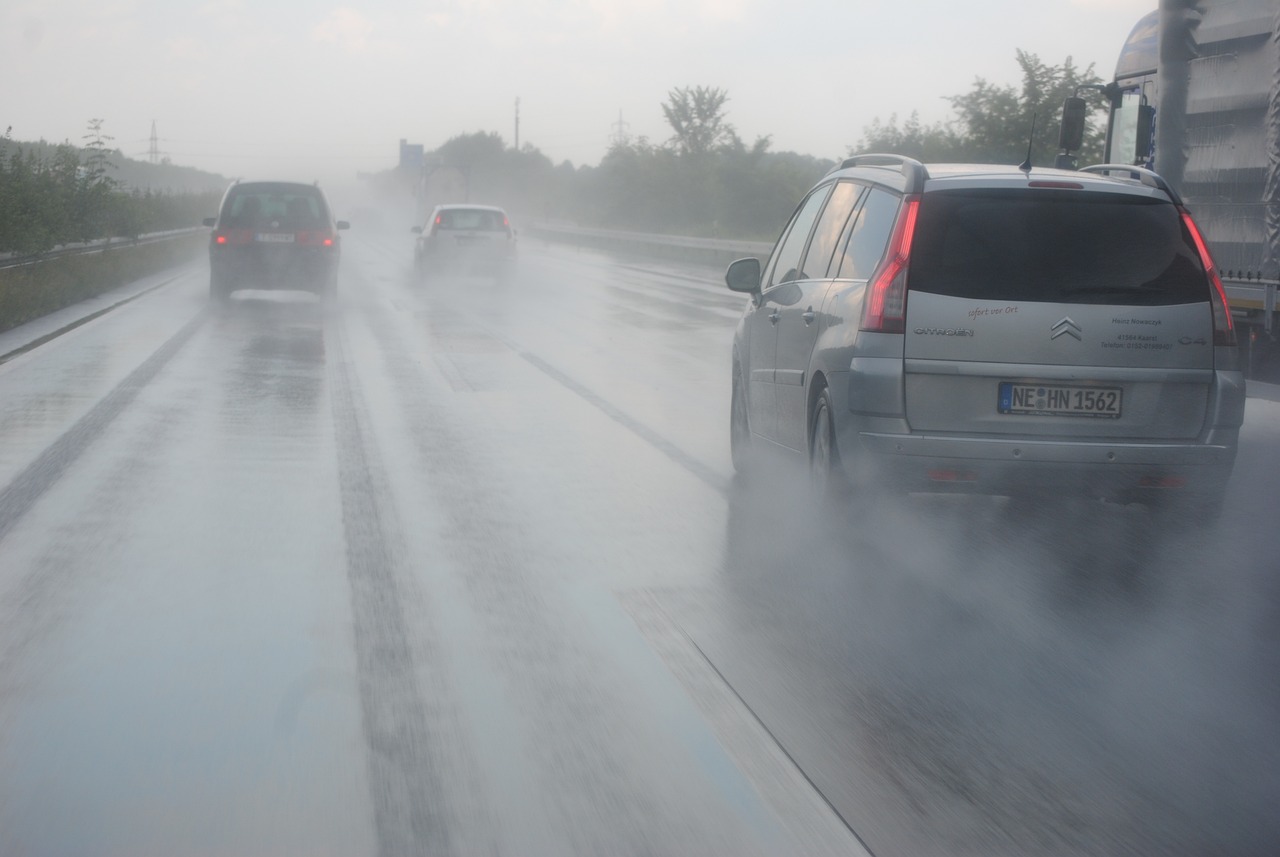Driving Safety Measures with Human Behavior
When we think about driving safety, our minds often jump to road signs, seat belts, and speed limits. However, there's a crucial element that frequently gets overlooked: human behavior. It's fascinating how our thoughts, feelings, and reactions can significantly influence our driving habits. Understanding this intersection between psychology and driving is essential for creating effective safety measures. After all, even the best safety protocols can fall short if the drivers behind the wheel are not in the right mindset. So, how do we bridge the gap between road safety and the human psyche?
At the core of driving lies a complex web of emotions and psychological factors. For instance, did you know that a driver who is feeling stressed or angry is more likely to make impulsive decisions? This impulsiveness can lead to a host of dangerous situations, from speeding to aggressive maneuvers. Understanding these psychological triggers can help us develop strategies to mitigate their impact. By recognizing how emotions and mental states affect our driving, we can implement measures that not only promote safety but also encourage drivers to be more mindful on the road.
Moreover, there’s an undeniable connection between emotional well-being and driving performance. Think about it: when you're feeling good, you're more focused, aware, and less likely to engage in risky behaviors. On the other hand, when stress or anxiety creeps in, your ability to react to sudden changes in traffic can diminish. This brings us to the importance of stress management techniques and emotional regulation in driving safety. By fostering a better understanding of our own emotional states, we can create a safer driving environment for ourselves and others.
In summary, driving safety measures cannot solely rely on physical precautions. They must also consider the intricacies of human behavior. By enhancing our understanding of the psychological factors that influence driving, we can craft a more holistic approach to road safety that addresses both the mental and physical aspects of driving. So, let’s dive deeper into how emotions, stress, and distractions shape our driving experiences and what we can do to drive safer.
Understanding the psychological aspects of driving can help identify risk factors that lead to unsafe behavior on the road, including stress, aggression, and distractions. When we drive, we are not just operating a vehicle; we are engaging in a complex cognitive task that requires our full attention. The mind is a powerful tool, but when it’s clouded by negative emotions or external distractions, it can lead to dangerous situations. Recognizing these psychological elements is the first step in improving driving safety.
Emotions play a significant role in driving behavior. When we are behind the wheel, feelings such as anger, anxiety, and even excitement can drastically alter our decision-making processes. Have you ever noticed how a bad day can make you more impatient on the road? Or how a rush of excitement can lead to speeding? It's essential to understand how these emotions can cloud our judgment and lead to unsafe driving practices. By acknowledging and managing our feelings, we can enhance our focus and make safer choices on the road.
Stress can impair a driver's ability to concentrate and react quickly. When you're stressed, your mind is racing, and your body is tense, making it challenging to focus on the task at hand—driving. This subsection discusses the effects of stress on driving performance and offers strategies for managing it. Stress can lead to a higher likelihood of accidents, as it hampers our ability to think clearly and make sound decisions. Recognizing when we are stressed and taking proactive steps to alleviate that stress can significantly improve our driving safety.
Recognizing common stress triggers while driving can help individuals develop coping mechanisms to maintain focus and safety on the road. Some common triggers include heavy traffic, aggressive drivers, or even running late. By identifying these stressors, drivers can prepare themselves mentally and emotionally to handle these situations more effectively. It’s like having a game plan before entering a challenging situation—knowing what to expect can make all the difference.
Implementing stress-relief techniques, such as deep breathing or mindfulness, can enhance a driver's ability to handle challenging situations effectively. Simple practices, like taking a few deep breaths before starting your car or practicing mindfulness during your drive, can create a calmer mindset. These techniques not only improve your emotional state but also enhance your overall driving experience, making it safer for you and everyone else on the road.
Road rage is a dangerous manifestation of aggression while driving. It can escalate quickly, leading to reckless behavior that endangers lives. This section explores its causes, consequences, and ways to mitigate aggressive behavior on the road. Understanding the triggers of road rage—like feeling cut off or being stuck in traffic—can help drivers develop strategies to remain calm and composed, thus promoting safer driving conditions for everyone.
Distractions are a leading cause of accidents. This section highlights various types of distractions, including mobile devices and passengers, and their effects on driver attention. The modern world is full of distractions, and the car is no exception. From text messages to in-car entertainment systems, distractions can pull our focus away from the road, leading to potentially dangerous situations.
The rise of technology has introduced new distractions for drivers. Smartphones and in-car systems can divert attention from the road. It's essential to recognize how these devices can impact our driving. For instance, sending a quick text might seem harmless, but it can take your eyes off the road for critical seconds. Understanding the dangers of these distractions is key to fostering safer driving habits.
Passengers can either support safe driving or contribute to distractions. This section examines how the behavior of passengers affects driver focus and safety. Engaging in lively conversations or having kids in the backseat can create a dynamic environment that may lead to distractions. It's vital for drivers to communicate their need for focus and set boundaries to ensure a safer driving experience.
- What are the most common psychological factors affecting driving?
Stress, aggression, and distractions are the most common psychological factors that can lead to unsafe driving behavior. - How can I manage stress while driving?
Implementing techniques such as deep breathing, taking breaks, and practicing mindfulness can help manage stress effectively. - What should I do if I feel road rage?
It's important to recognize the triggers of your anger and take steps to calm down, such as pulling over to take a break or practicing relaxation techniques. - How can passengers help in promoting safe driving?
Passengers can support safe driving by being calm, avoiding distractions, and communicating effectively with the driver.

The Psychology of Driving
This article explores the intersection of driving safety measures and human behavior, highlighting how psychological factors influence driving habits and the effectiveness of safety protocols.
Understanding the psychological aspects of driving can unlock a treasure trove of insights into why we sometimes make risky choices on the road. Imagine driving as a complex dance where every step is influenced by our emotions, stress levels, and even the people around us. When we get behind the wheel, we’re not just operating a machine; we’re navigating a landscape filled with external pressures and internal conflicts. It’s like being in a high-stakes game where every decision counts, and the consequences can be dire.
At the heart of driving psychology are several key factors that can lead to unsafe behavior. These include stress, aggression, and distractions. Each of these elements can significantly impact our ability to focus, make sound judgments, and react to unexpected situations. For instance, have you ever noticed how your mood can change the way you drive? A bad day at work might make you more impatient, while a joyful moment can lead to a more relaxed driving experience. Understanding these emotions is crucial for improving driving safety.
Let's dive deeper into some of these psychological triggers:
- Stress: It clouds our judgment and slows our reaction times.
- Aggression: It can transform a simple traffic jam into a battlefield.
- Distraction: Even a moment's lapse in attention can lead to accidents.
By recognizing how these psychological factors intertwine with our driving habits, we can begin to formulate strategies to mitigate their effects. For instance, understanding that stress can lead to aggressive driving behaviors allows us to take proactive steps to manage our stress levels before hitting the road. It’s about creating a mental toolkit that prepares us for the unexpected.
Moreover, the role of emotions in driving cannot be overstated. They can act as either a guiding light or a dark cloud over our decisions. When we feel angry or anxious, our ability to make rational choices diminishes, leading to impulsive actions that compromise safety. A study conducted by the National Highway Traffic Safety Administration (NHTSA) revealed that emotional drivers are more likely to engage in risky behaviors, such as speeding or tailgating. This insight emphasizes the need for emotional awareness while driving.
In conclusion, the psychology of driving is a multifaceted subject that requires attention and understanding. By acknowledging the impact of stress, aggression, and emotional states on our driving habits, we can cultivate safer driving practices. Just like a skilled musician who adjusts their tempo based on the mood of the piece, we too can adjust our driving behaviors based on our psychological state. It's all about being mindful and taking control of our emotions behind the wheel.
- What are some common psychological factors that affect driving?
Common factors include stress, aggression, and distractions. - How can I manage stress while driving?
Techniques like deep breathing, listening to calming music, and planning your route can help. - What should I do if I feel angry while driving?
Take a moment to breathe, pull over if necessary, and remind yourself of the importance of safety.

Influence of Emotions on Driving
When it comes to driving, emotions can act like the wind beneath our wings or the storm that capsizes our ship. Have you ever noticed how your mood can change the way you handle a vehicle? It's fascinating, yet a bit alarming, how feelings such as anger, anxiety, and even excitement can influence our driving habits. Understanding this emotional landscape is crucial for anyone who wants to be a safer driver. After all, driving isn't just about handling the car; it's about managing the mind behind the wheel.
Consider this: when you’re feeling angry, your body is flooded with adrenaline. This can lead to aggressive driving behaviors, such as speeding or tailgating. In fact, studies show that drivers who experience high levels of anger are more likely to engage in risky maneuvers on the road. It's almost like driving with blinders on—your focus narrows, and your ability to react to potential hazards diminishes. On the flip side, when you’re feeling anxious, you might overthink every little decision, second-guessing your moves and causing hesitation that can lead to accidents. This emotional rollercoaster can create a dangerous cocktail of behaviors that put both you and others at risk.
But emotions don’t just affect your driving—they also influence how you respond to other drivers. For example, if someone cuts you off, your immediate emotional reaction might be to retaliate. This can escalate into a dangerous situation known as road rage, where the emotional response overrides rational thought. It’s essential to recognize these feelings as they arise and to have strategies in place to diffuse them. A simple deep breath or a moment of reflection can make all the difference in keeping your cool on the road.
So, how do we manage these emotional triggers while driving? Here are a few strategies:
- Awareness: Acknowledge your feelings before you start driving. If you're feeling particularly emotional, it might be best to take a moment to calm down.
- Mindfulness: Practice being present in the moment. Focus on the road and your surroundings rather than the thoughts swirling in your head.
- Take Breaks: If you find yourself feeling overwhelmed, pull over safely and take a few moments to regroup.
In summary, emotions can be powerful forces that shape our driving experiences. Recognizing their influence allows us to take control of our reactions and make safer choices behind the wheel. Remember, driving is not just about the destination; it's also about the journey and how we navigate our emotional landscapes along the way.

Stress and Driving
Driving is often seen as a routine activity, but when stress enters the equation, it can transform a simple commute into a hazardous journey. Stress can cloud a driver's judgment, impair their concentration, and delay their reaction times, making it a significant risk factor on the roads. Imagine trying to juggle a dozen tasks while navigating through traffic; that’s what driving under stress feels like. The chaotic environment of the road, combined with personal stressors, can lead to dangerous situations.
When stress levels rise, the brain's ability to process information diminishes. Drivers may find themselves unable to respond to sudden changes in traffic or react appropriately to the behavior of other drivers. For instance, a driver who is stressed out from work may become easily frustrated with slow-moving traffic or erratic drivers, leading to aggressive driving behaviors. It's crucial to recognize that stress doesn't just affect the individual driver; it has a ripple effect on everyone sharing the road.
To better understand how stress impacts driving, we can look at some common stress triggers that drivers face:
- Time Pressure: Rushing to meet deadlines can lead to risky driving behaviors.
- Traffic Congestion: Being stuck in traffic can heighten feelings of frustration and anxiety.
- Personal Issues: Life challenges, such as family problems or financial worries, can distract drivers.
Recognizing these stress triggers is the first step toward managing them effectively. By identifying what causes stress while driving, individuals can develop coping mechanisms to maintain focus and safety on the road. For example, if traffic congestion is a major stressor, planning routes ahead of time or leaving earlier can alleviate some of that anxiety.
Moreover, implementing stress-relief techniques can significantly enhance a driver's ability to handle challenging situations. Techniques such as deep breathing exercises, mindfulness, or even listening to calming music can help create a more relaxed driving environment. Just a few moments of focused breathing before getting behind the wheel can make a world of difference in how one approaches the drive.
Ultimately, managing stress while driving is about creating a mindset that prioritizes safety and calmness. By being aware of stressors and actively working to mitigate their effects, drivers can not only protect themselves but also contribute to a safer driving environment for everyone. After all, a calm driver is a safe driver, and that’s a goal worth striving for.
- How can I identify if I'm driving under stress? Look for signs such as irritability, difficulty concentrating, and aggressive reactions to other drivers.
- What are some effective stress-relief techniques while driving? Techniques like deep breathing, listening to soothing music, and practicing mindfulness can help.
- Can stress lead to accidents? Yes, stress can impair judgment and reaction times, increasing the likelihood of accidents.

Identifying Stress Triggers
When it comes to driving, understanding the factors that trigger stress can be a game-changer for maintaining safety on the road. Imagine you're in your car, and suddenly, a car cuts you off. Your heart races, your palms sweat, and just like that, your focus shifts from the road to your rising frustration. This scenario is all too common, and recognizing these stress triggers is crucial for keeping your cool behind the wheel.
Some common stress triggers include:
- Traffic Congestion: Stuck in a jam? It's like watching paint dry, and it can really test your patience.
- Time Pressure: Rushing to an appointment can lead to reckless decisions. Ever been late and thought, "I'll just speed a little"?
- Unexpected Road Conditions: Potholes, construction, or sudden weather changes can throw anyone off their game.
- Other Drivers: Aggressive or distracted drivers can elevate your anxiety levels quickly.
By identifying these triggers, you can start to develop strategies to manage your reactions. For instance, if you know that traffic congestion stresses you out, consider leaving earlier to avoid the rush. Or, if you find yourself getting frustrated with other drivers, practice deep breathing techniques to help you stay calm.
It's also important to keep a journal of your driving experiences. Documenting when you felt stressed and what caused it can provide valuable insights into your behavior. Over time, you'll begin to notice patterns, which can help you anticipate and mitigate stress before it escalates.
Ultimately, the key to safe driving lies in your ability to recognize and address these stress triggers proactively. By doing so, you not only enhance your own safety but also contribute to a more peaceful driving environment for everyone on the road.
- What are some common stress triggers while driving? Common triggers include traffic congestion, time pressure, unexpected road conditions, and aggressive drivers.
- How can I manage stress while driving? Techniques such as deep breathing, leaving earlier to avoid traffic, and documenting your experiences can help manage stress.
- Why is it important to identify stress triggers? Recognizing stress triggers allows you to develop coping strategies, enhancing both your safety and that of others on the road.

Stress-Relief Techniques
When it comes to driving, stress can be a silent killer, lurking beneath the surface and affecting our ability to respond to the ever-changing environment on the road. So, how do we combat this invisible foe? First off, awareness is key. Recognizing when stress is creeping in allows us to take proactive steps to manage it. Techniques such as deep breathing can be incredibly effective. Imagine inhaling deeply through your nose, filling your lungs completely, and then exhaling slowly through your mouth. This simple act can not only calm your mind but also help lower your heart rate, making you more focused when you’re behind the wheel.
Another powerful method is mindfulness meditation. This practice encourages you to remain present in the moment, which can be particularly beneficial while driving. By focusing on your surroundings, you can reduce anxiety and enhance your concentration. Picture yourself sitting in a quiet space, closing your eyes, and visualizing a peaceful drive. This mental exercise can translate into a calmer demeanor on the road.
Additionally, engaging in regular physical activity can reduce stress levels significantly. Whether it’s a brisk walk, a jog, or a yoga session, moving your body releases endorphins, which are natural mood lifters. Not only does this make you feel better overall, but it also prepares you mentally for the challenges of driving. Think of it as tuning up your car before a long journey; your body deserves the same care!
Furthermore, consider incorporating music therapy into your driving routine. Listening to your favorite tunes can elevate your mood and help drown out negative thoughts that contribute to stress. Create a playlist of songs that make you feel good and keep it handy for those moments when you need a quick emotional boost. Just be sure to keep the volume at a level that won't distract you from the road.
Lastly, it’s crucial to plan your routes ahead of time. Nothing spikes stress levels like being lost or stuck in traffic. By taking a few moments to review your route before you hit the road, you can reduce anxiety and travel with greater confidence. You can even use navigation apps that provide real-time traffic updates, allowing you to avoid congested areas and stay calm.
In summary, managing stress while driving is not just about coping with the immediate pressures of the road; it’s about creating a holistic approach to your mental well-being. By integrating techniques such as deep breathing, mindfulness, physical activity, music therapy, and route planning into your driving routine, you can transform your experience from stressful to serene. Remember, a relaxed driver is a safer driver!
- What are some quick stress-relief techniques I can use while driving?
Practicing deep breathing, listening to calming music, or taking short breaks can help alleviate stress on the road. - How can mindfulness improve my driving?
Mindfulness helps you stay present and focused, reducing anxiety and distractions while driving. - Is physical activity really beneficial for driving stress?
Yes! Regular exercise releases endorphins that improve your mood and help you handle stress better. - Can I use my smartphone to help manage stress while driving?
Absolutely, but use it responsibly. Navigation apps can help you avoid traffic, and music apps can provide your favorite tunes to keep you calm.

Aggression and Road Rage
Aggression and road rage are serious issues that can turn a routine drive into a hazardous situation. Imagine you’re cruising down the highway, the sun is shining, and you’re in a good mood, when suddenly, another driver cuts you off. Your heart races, and before you know it, anger bubbles up inside you. This is a common scenario that highlights how quickly emotions can escalate while behind the wheel. Road rage is not just a mild irritation; it can lead to dangerous confrontations, reckless driving, and even accidents. Understanding the roots of this aggression is crucial for promoting safer roads.
The factors that contribute to road rage are varied and often intertwined. Stress from daily life, a feeling of anonymity while driving, and the pressure of time can all fuel aggressive behavior. When drivers feel rushed, they may become impatient, leading to aggressive maneuvers like tailgating or weaving through traffic. It’s essential to recognize that these behaviors not only endanger the aggressive driver but also everyone else on the road. The consequences of road rage can be severe, ranging from minor fender benders to catastrophic collisions.
So, what can we do to combat road rage? Here are a few strategies:
- Stay Calm: Practicing deep breathing and mindfulness can help maintain your composure when faced with aggressive drivers.
- Give Space: If another driver is behaving erratically, it’s often best to create distance rather than engage.
- Don’t Take It Personally: Remember that aggressive driving often stems from the other driver’s issues, not yours.
By incorporating these strategies into your driving routine, you can help reduce the likelihood of road rage incidents. Additionally, it’s important to educate others about the dangers of aggressive driving. Awareness campaigns can play a significant role in changing attitudes and behaviors on the road. Schools, workplaces, and community organizations can all contribute to spreading the word about safe driving practices.
In summary, aggression and road rage are complex issues that require a multifaceted approach to address. By understanding the psychological triggers that lead to aggressive behavior and implementing strategies to mitigate these reactions, we can all contribute to a safer driving environment. Remember, the road is a shared space, and a little patience and kindness can go a long way in preventing road rage.
Q: What are the main causes of road rage?
A: Road rage can stem from various factors, including stress, time pressure, and a feeling of anonymity while driving. These triggers can lead to aggressive driving behaviors.
Q: How can I manage my anger while driving?
A: Techniques such as deep breathing, listening to calming music, and reminding yourself that other drivers may be having a bad day can help manage anger.
Q: What should I do if I encounter an aggressive driver?
A: The best response is to avoid engaging with the aggressive driver. Maintain a safe distance and, if necessary, report the behavior to the authorities.
Q: Can road rage lead to accidents?
A: Absolutely. Aggressive driving behaviors increase the likelihood of accidents, as they often involve risky maneuvers and a lack of attention to the road.

Distractions and Their Impact
When it comes to driving, distractions can be like the sneaky ninjas of the road—silent but deadly. They creep in when you least expect it and can have catastrophic consequences. According to research, distractions are a leading cause of accidents, and understanding them is crucial for maintaining safety. The truth is, our attention is a precious resource, and once it’s diverted, we become vulnerable to making mistakes that could endanger ourselves and others. So, let’s dive into the different types of distractions that drivers face.
Distractions can be broadly categorized into three main types: visual, manual, and cognitive. Visual distractions take your eyes off the road, manual distractions involve taking your hands off the wheel, and cognitive distractions divert your mental focus from driving. Imagine trying to juggle while riding a unicycle—each task requires your full attention, and dropping one could lead to a crash. Here’s a quick breakdown of these distractions:
| Type of Distraction | Description | Examples |
|---|---|---|
| Visual | Taking your eyes off the road | Looking at a GPS, billboards, or checking your phone |
| Manual | Taking your hands off the steering wheel | Eating, drinking, or adjusting controls |
| Cognitive | Diverting your mental focus | Daydreaming, talking to passengers, or worrying |
Among these distractions, technology has emerged as a significant player. With the rise of smartphones and in-car systems, drivers are now more tempted than ever to check messages or scroll through social media while behind the wheel. This behavior is akin to trying to read a novel while running a marathon—impossible to do effectively and incredibly risky. Studies show that texting while driving increases the risk of crashing by 23 times. That’s a staggering statistic that should make anyone think twice before reaching for their phone!
But it’s not just technology that’s a problem. Passengers can also be a source of distraction. While some passengers contribute to a fun and relaxed environment, others might engage in conversations that draw the driver’s attention away from the road. Have you ever been in a car where the conversation got so heated that you forgot to check your mirrors? It's a common scenario. The dynamics of the passenger-driver relationship can significantly impact driving safety. For instance, a chatty friend might inadvertently lead to a lapse in concentration, while a more subdued passenger can help maintain focus.
In conclusion, distractions are a complex web of factors that can jeopardize driving safety. Whether it’s the allure of a smartphone or the lively chatter of passengers, each distraction has the potential to pull our attention away from the road. Recognizing these distractions is the first step toward mitigating their impact. By being aware of what can divert our focus, we can take proactive measures to minimize their effects and ensure a safer driving experience for everyone.
- What are the most common distractions while driving? The most common distractions include texting, talking on the phone, eating, adjusting the radio, and interactions with passengers.
- How can I minimize distractions when driving? To minimize distractions, keep your phone out of reach, set your GPS before starting your trip, and limit conversations with passengers.
- Are distractions more dangerous for new drivers? Yes, new drivers may be more susceptible to distractions due to inexperience, making it crucial for them to practice focused driving.

Technology Distractions
In our fast-paced, tech-savvy world, the rise of technology has transformed our daily lives in countless ways, but it has also introduced a plethora of distractions that can jeopardize driving safety. Imagine this: you're cruising down the highway, music playing softly, and suddenly, your phone buzzes with a notification. In that split second, your attention shifts from the road to your screen, and just like that, you’ve entered a dangerous territory. This scenario is all too common and highlights how technology can swiftly divert our focus.
Smartphones, in particular, have become a double-edged sword. While they provide us with navigation tools and hands-free calling options, they also tempt us with social media alerts, texts, and emails that can be incredibly hard to ignore. According to recent studies, texting while driving increases the risk of crashing by 23 times. This staggering statistic emphasizes the critical need for drivers to recognize the potential hazards associated with technology use behind the wheel.
Moreover, in-car systems designed to enhance our driving experience can also become sources of distraction. Features like touchscreens, voice commands, and even built-in navigation systems can pull our attention away from the road. For instance, fiddling with a GPS while trying to navigate through traffic can be just as dangerous as texting. It’s essential to understand that multitasking in these situations can lead to split-second decisions that may have dire consequences.
To illustrate the impact of technology distractions, consider the following table:
| Type of Technology | Distraction Level | Examples |
|---|---|---|
| Smartphones | High | Texting, Social Media, Calls |
| In-Car Navigation | Medium | GPS Input, Map Adjustments |
| Entertainment Systems | Medium | Changing Music, Adjusting Volume |
| Passengers | Variable | Conversation, Arguments |
As the table indicates, different types of technology come with varying levels of distraction. Understanding these differences can help drivers make informed decisions about their use of technology while on the road. For example, a driver might choose to silence their phone and rely on a pre-set playlist to minimize distractions. It’s all about prioritizing safety over convenience.
In conclusion, while technology has undeniably made our lives easier, it’s crucial to recognize its potential dangers when driving. By being aware of the distractions presented by smartphones and in-car systems, drivers can take proactive steps to minimize risks. After all, your safety—and the safety of others on the road—should always come first. So, the next time you’re tempted to check your phone while driving, ask yourself: is that notification really worth the risk?
- What are the main distractions caused by technology while driving?
The main distractions include texting, using social media, adjusting in-car navigation systems, and interacting with entertainment systems.
- How can I minimize distractions from my smartphone while driving?
Consider using "Do Not Disturb" mode, set your phone to silent, or place it out of reach to avoid the temptation of checking notifications.
- Are in-car systems safer than using a smartphone?
While in-car systems can be safer if designed for hands-free use, they can still distract drivers if not used properly. It's essential to familiarize yourself with these systems before driving.

Passenger Influence
When you think about driving, it’s easy to focus solely on the driver’s behavior. However, passengers can significantly influence how a driver performs on the road. Imagine you’re cruising down the highway, music blasting, and your friends are laughing and chatting in the backseat. While it might seem fun, their presence can either enhance your driving experience or lead to distractions that could jeopardize safety.
One of the most critical aspects of passenger influence is the dynamic of distraction. Passengers can engage in conversations that pull the driver’s attention away from the road. This is especially true if the conversation is heated or emotionally charged. For instance, if a passenger is sharing a thrilling story or expressing strong emotions, the driver might be tempted to engage too deeply, causing them to lose focus on their surroundings. In fact, studies have shown that engaging in a lively conversation can increase the likelihood of accidents, as it diverts cognitive resources away from driving.
On the flip side, passengers can also serve as a support system for drivers. They can help maintain a calm atmosphere, remind the driver to stay focused, or even assist with navigation. For example, if a driver is feeling overwhelmed by traffic, a calm passenger can help by discussing light topics or offering encouragement. This positive influence can help mitigate stress and keep the driver’s attention where it belongs—on the road.
To better understand how passengers can impact driving behavior, consider the following factors:
- Type of Passenger: The relationship between the driver and the passenger can play a significant role. Close friends might engage in more distracting behaviors compared to a quiet acquaintance.
- Emotional State: If a passenger is anxious or upset, their energy can transfer to the driver, potentially increasing stress levels.
- Communication Style: Passengers who communicate clearly and calmly can help drivers stay focused, while those who are loud or animated may cause distractions.
In essence, the influence of passengers on driving behavior is a double-edged sword. While they can provide support and enhance the driving experience, they can also become significant distractions. Therefore, it’s crucial for drivers to be aware of the dynamics at play and to communicate their needs to their passengers. Setting ground rules, like asking passengers to keep the volume down or limiting intense discussions during critical driving moments, can help maintain focus and safety on the road.
Ultimately, a driver’s ability to manage passenger influence effectively can lead to a safer driving environment for everyone involved. By fostering a supportive atmosphere and being mindful of distractions, both drivers and passengers can contribute to a more secure and enjoyable journey.
- How can passengers help improve driving safety?
Passengers can enhance driving safety by keeping the atmosphere calm, avoiding distractions, and providing assistance with navigation.
- What should I do if my passengers are being distracting?
If passengers are distracting you, it's essential to communicate clearly. Politely ask them to lower their voices or focus on less intense topics while you drive.
- Can a passenger's emotional state affect driving?
Yes, a passenger's emotional state can significantly impact a driver's focus and stress levels. It's best to maintain a calm environment in the vehicle.
Frequently Asked Questions
- What psychological factors influence driving behavior?
Psychological factors such as stress, aggression, and emotional states can significantly affect driving behavior. For instance, when a driver is stressed or angry, their ability to concentrate and react appropriately can be compromised, leading to unsafe driving practices.
- How do emotions impact driving safety?
Emotions like anger and anxiety can cloud judgment and lead to impulsive decisions on the road. When drivers are overwhelmed by their feelings, they might engage in risky behaviors, such as speeding or aggressive driving, which can increase the likelihood of accidents.
- What are common stress triggers while driving?
Common stress triggers include heavy traffic, time constraints, and conflicts with other drivers. Recognizing these triggers can help drivers develop strategies to manage their stress and maintain focus while driving.
- What techniques can help reduce stress while driving?
Techniques such as deep breathing exercises, mindfulness, and listening to calming music can help alleviate stress while driving. Implementing these strategies can enhance a driver's ability to stay calm and focused on the road.
- What is road rage and how can it be mitigated?
Road rage refers to aggressive behavior exhibited by drivers, often triggered by frustration or anger. To mitigate road rage, drivers can practice patience, avoid engaging with aggressive drivers, and use relaxation techniques to maintain composure.
- What types of distractions are most common while driving?
Common distractions include mobile devices, adjusting in-car entertainment systems, and interactions with passengers. These distractions can significantly impair a driver's ability to focus and react to road conditions.
- How does technology contribute to driving distractions?
Smartphones and in-car technology can divert a driver's attention from the road. Texting, checking notifications, or even navigating through apps can lead to dangerous situations if not managed properly.
- How can passengers influence a driver's attention?
Passengers can either support safe driving by being calm and quiet or contribute to distractions through loud conversations or arguments. It's essential for drivers to communicate their need for focus to ensure safety on the road.



















